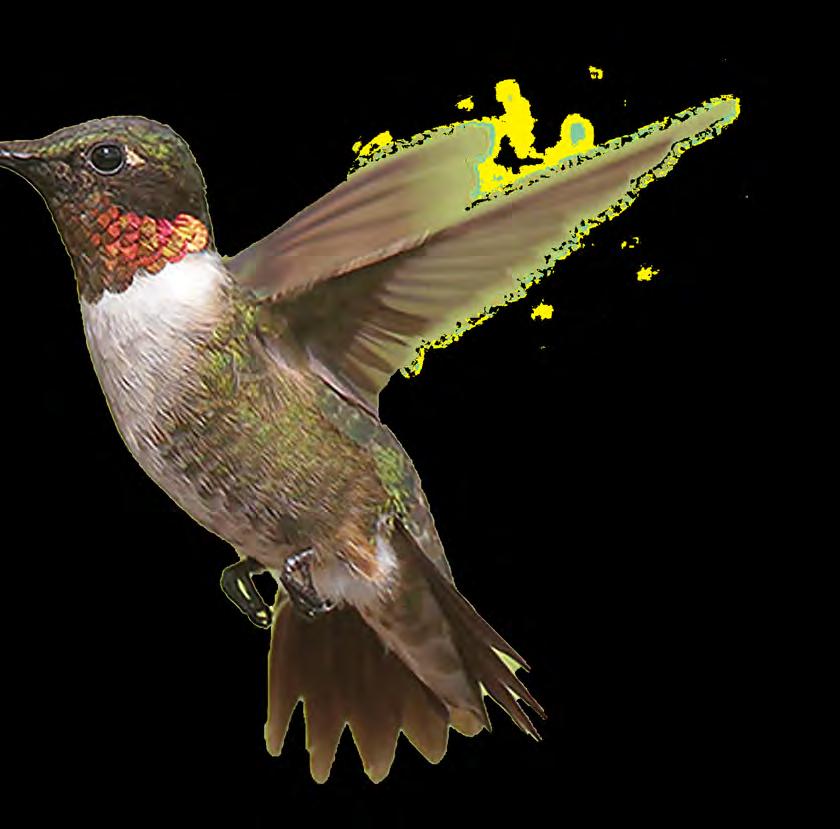
3 minute read
Fighting for Our Feathered Friends is ABC
Fighting for Our Feathered Friends is ABC
By Anita L. Sherman
Advertisement
They’re gone now. Hummingbirds headed by the millions for points far south. For many in these parts, hanging out the hummingbird feeders is an annual ritual the porches, yards and gardens would not be without.
During the spring and summer, we watch for their frequent, often frenetic, feeding visits. We delight and wonder at the speed of their flight, the pin-pointed accuracy of their sucking prowess and their often territorial protectiveness of nectar bearing flowers or homemade sugar water.
We delight in observing them and wouldn’t want them to go away forever. They’re inspiring…so small but so strong. We count on their annual return. But who watches over them?
Fauquier County has a reputation and long legacy in land conservation and preservation thwarting efforts at rampant development. Much of the county remains rural and that is by design.
That same spirit of saving the environment extends to birdlife as well. With offices in The Plains and Washington, D.C., the American Bird Conservancy (ABC) may be located locally but its reach is global. The headquarters for ABC has always been in The Plains. They also have remote field staff scattered across the country.
Celebrating a 25-year anniversary, this nonprofit works diligently to conserve wild birds and their habitats.
Across the Americas, more than 500 native bird species are threatened with extinction — 12 percent of 4,230 species. In the United States alone, nearly 300 of 750 native bird species, or 37 percent, are declining in population.
ABC’s efforts are measurable in preventing the extinction of endangered birds, conserving bird habitat, reducing threats to birds and building a community of bird conservationists.
Creating partnerships throughout the Americas, they work with local, regional and national agencies as well as private land managers to protect environments for threatened species.

The ruby-throated hummingbird was chosen as the symbol of the American Bird Conservancy in The Plains for its small yet feisty nature.
Headlines on their website share the news of brown-headed Nuthatches return to Missouri, a South Dakota project that benefits the Great Plains birds and working lands, and fixing power lines and street lights to save seabirds and sea turtles in Hawaii to name just a few.
Birds serve as indicators of a healthy environment. Their sensitivity to habitat change is a tool that ecologists can measure. According to their website, “whether ecosystems are managed for agricultural production, wildlife, water, or tourism, success can be measured by the health and diversity of bird populations.”
Protecting birds may be a laudable goal and seemingly not controversial. But the work is challenging when it collides with human-caused threats like window strikes, collisions with wind turbines, use of pesticides, and poorly managed fisheries. And then, there are all those free-roaming cats.
“Cats kill approximately 2.4 billion birds every year in the U.S. alone, making cat predation by far the largest source of direct, human-caused mortality to birds,” said ABC’s Director of Public Relations, Jordan Rutter. “Up to a billion birds die in collisions with glass each year in the United States.”
“These two threats are all around us and ones that folks can take action on today. Safely containing cats when outside and treating windows are solutions anyone can do.”
Thanks to an avid bird watcher, ABC was created on Nov. 1, 1994 by George Fenwick. His desire to build a fearless conservation group that wasn’t afraid to tackle challenging issues like pesticides and free-roaming predators.
Back to the hummingbird. It was chosen as the logo symbol for its small but feisty and persistent nature. The qualities have boded well as the organization continues to ensure native bird species and their habitats are protected.
Mike Parr, ABC’s president, joined in 1996 after graduating from the University of East Anglia in England and working for BirdLife International. He’s chair of the Alliance for Zero Extinction and a member of the board of directors of the Sustainable Forestry Initiative.
“I’m proud of the incredible results we’ve achieved for birds across the Western Hemisphere in our first 25 years,” said Parr. “That said, current threats continue to grow, and new threats are emerging. Twenty-five years from now, we need the situation to be better, not worse, for birds. “ABC will be stepping up our game, helping birds and bringing the bird community together, into the next 25 years and beyond. Though the challenges ahead are many, conservation success always starts with a few people who really care, then move it forward. Let’s make it so.”
To learn more about the American Bird Conservancy, visit www.abcbirds.org.










